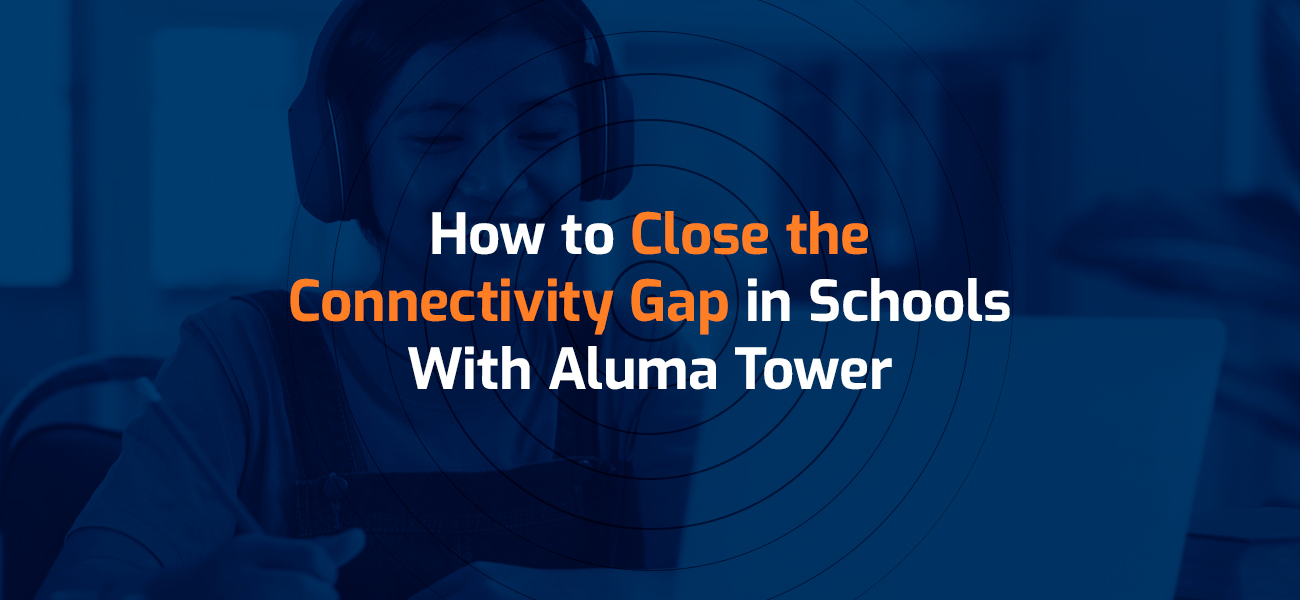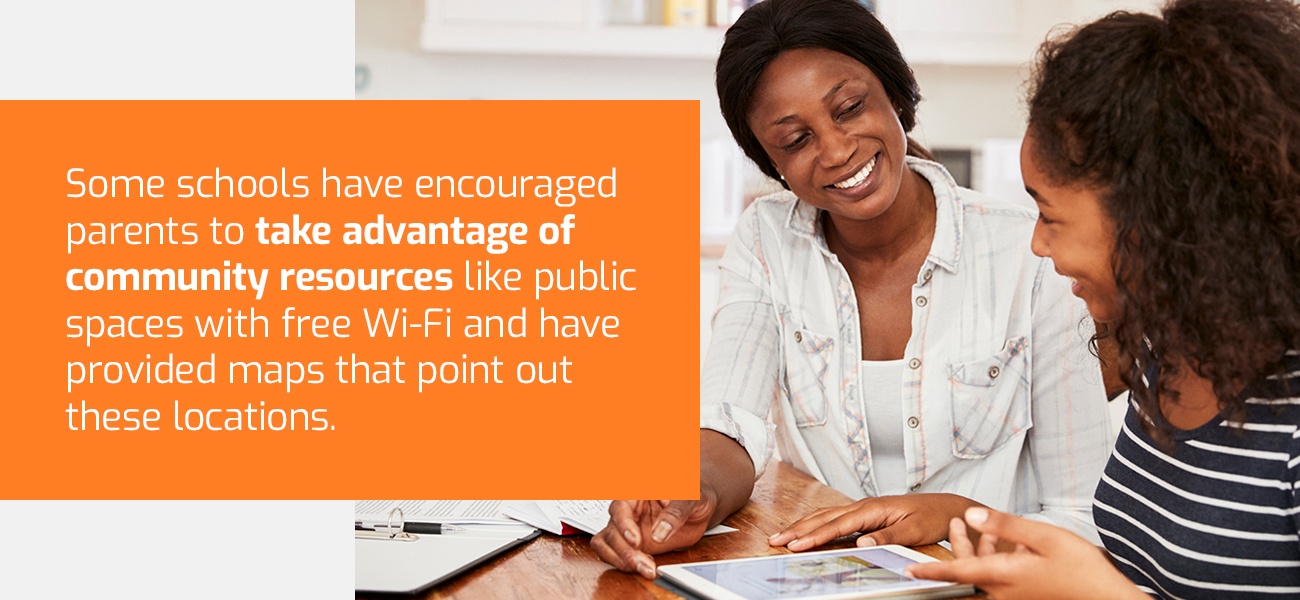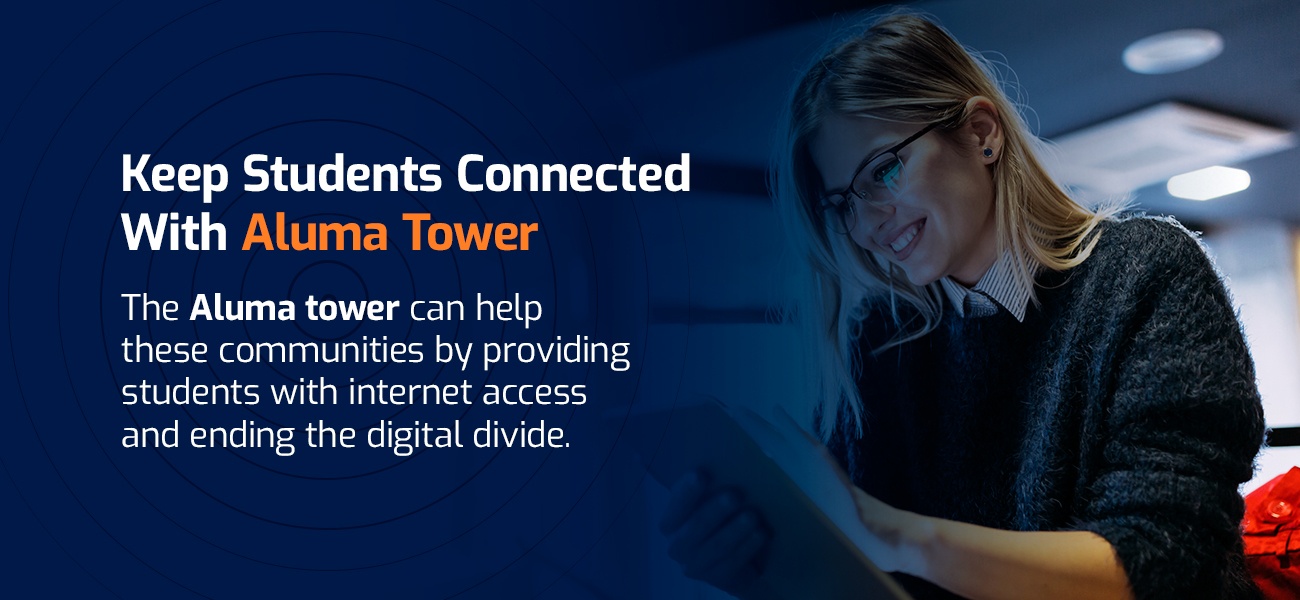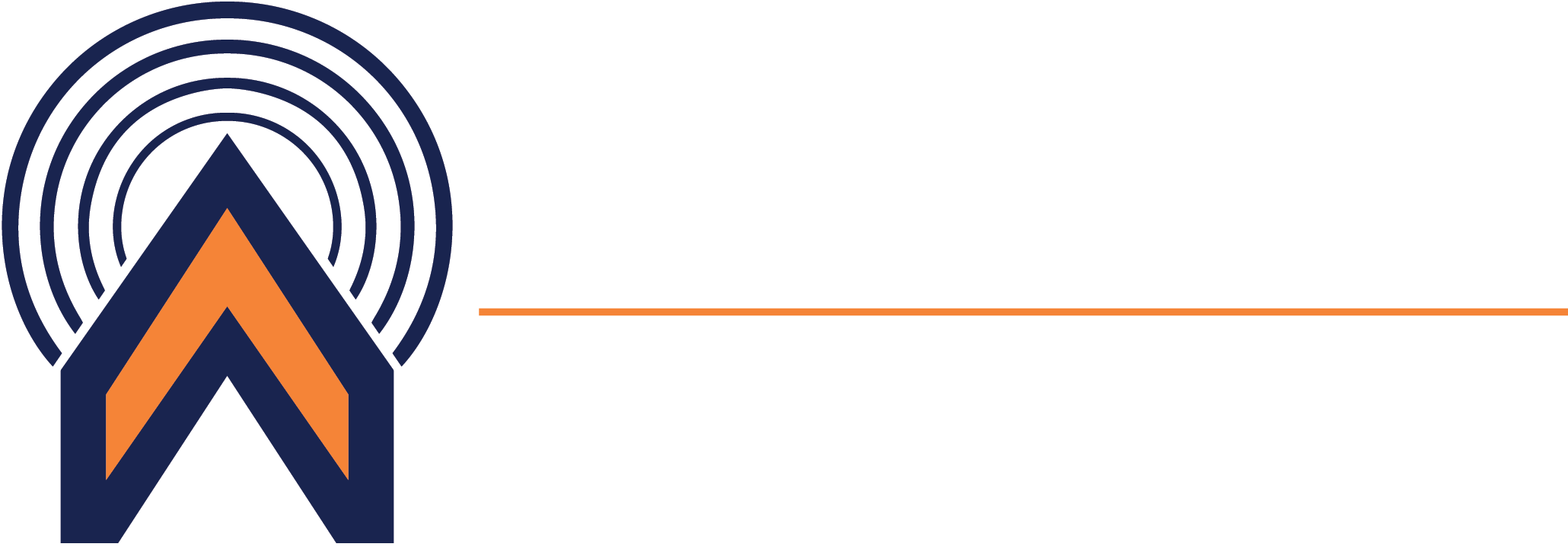How to Close the Connectivity Gap in Schools with Aluma Tower

Internet access in schools is essential, but what happens when students are no longer doing their work inside the school building? When students go home to complete assignments or participate in remote learning, a lack of internet access can become a significant obstacle. Below, you’ll learn more about the connectivity gap, how it affects students and how you can empower children and closing the connectivity gap using Aluma towers.
The Role of Internet in Education
The internet and other technological developments have opened up a world of possibilities for teachers and students. They can enhance the quality of education by:
- Helping teachers and students connect remotely
- Allowing students to conduct research remotely, at a time of their choosing
- Providing access to interactive learning tools
- Improving students’ digital literacy
Every child deserves a quality education, which means having access to a quality internet connection.
Children who have highspeed internet access in their homes can:
- Check their emails to see if there is any communication from their teachers with changes in the plans for that day
- Ensure that they can receive any homework assignments and submit homework assignments in real time
- Ensure that communication among their peers is easy and streamlined
- Collaborate with classmates on difficult homework assignments and conduct research to problem solve
What is the Connectivity Gap?
Unfortunately, while the majority of children have internet access, there are still large portions of the population who do not, either because of economic constraints or infrastructure limitations. The connectivity gap, also called the digital divide, refers to the fact that some students do not have internet access.
The Federal Communications Commission’s (FCC) benchmark for broadband is a download speed of 25 megabits per second (Mbps) and an upload speed of 3 Mbps. According to the FCC’s 2020 Broadband Deployment Report, internet connectivity is improving each year throughout the country, but many families and schools still lack access.
Only 73% of Americans have a broadband connection in their household. That means more than a quarter of Americans are going without broadband at home. When it comes to schools, just 38% of school districts meet the FCC’s long-term broadband connectivity goal of 1 billion bits per second (Gbps) per 1,000 users. Approximately 750,000 students are in school districts that don’t even have access to 100 million bits per second (Mbps) per 1,000 students and staff.
Many students lack internet access due to two prominent issues:
- Lack of infrastructure: In some parts of the U.S., the infrastructure needed to deliver broadband simply isn’t there. The problem is pronounced in rural and tribal lands, where 3% and 27.7% of people, respectively, still don’t have access to fixed terrestrial 25/3 Mbps broadband. Compare that to only 1.5% of Americans lacking the same coverage in urban areas. Even for Americans who currently have internet access, we’ve seen how natural disasters can quickly wipe out Wi-Fi and cellular data infrastructure.
- Affordability: Even when the infrastructure is there, some Americans can’t afford to pay an internet service provider. The most recent census data from 2015 showed that the percentage of students without a high-speed internet connection at home was notably higher for low-income households. For students aged 6 to 17 whose annual household income was under $30,000, 35% lacked a high-speed internet That percentage was higher for Black and Hispanic children. Pew Research data from 2019 showed this economic digital divide continues.
All communities are suffering from a connectivity gap. This disparity was highlighted in 2020 when most students needed to be online. It’s important to note that even once students return to in-person classes, the connectivity gap will still be a pressing issue that schools must navigate. All students need internet access, whether they attend physical lessons or not. 2020 has shown that schools need to be better prepared for the next emergency, whatever it might look like.

How Does the Connectivity Gap Impact Students?
Students who don’t have a reliable internet connection at home may be negatively impacted in several ways. Two major issues include:
- Homework: For schools meeting in person, students still need internet access, in many cases, to complete assignments at home. In 2018, Pew Research Center surveyed teenagers and found that 17% — close to one in five — are sometimes or often unable to complete their homework because they can’t access a computer or an internet connection. Students are unable to complete assignments that help them master concepts, causing their grades to suffer.
- Remote learning: A quality internet connection is critical for students attending online school or attending a school that has temporarily taken their meetings online. In 2020, nearly 93% of households engaged in distance learning of some kind. In these setups, students without internet access at home can become disconnected from their teachers and classmates unless they find alternative ways to access the internet. This becomes challenging when community centers like libraries that offer free Wi-Fi are temporarily closed.
How Can the Connectivity Gap Be Closed?
Schools and families are working on ways to close the connectivity gap. There are two basic approaches to helping students who lack internet access:
- Providing offline resources: One approach which schools can take is to make their classes depend less on digital resources, especially for at-home assignments. Instead, teachers may send printed take-home resources to help students with homework or studying. Some schools may even try to make remote learning accessible offline.
- Improving access to the internet: Another approach to closing the connectivity gap is helping students get the access they need to reap the same benefits as their peers with quality internet at home. Some schools have encouraged parents to take advantage of community resources like public spaces with free Wi-Fi and have provided maps that point out these locations. Other schools offer mobile hotspots for students to use at home. In other cases, families may receive discounted rates to help them afford an internet connection at home.
Both of these approaches have some limitations. Focusing on offline resources limits the learning and communication tools schools can use. It also doesn’t help students develop their digital literacy skills, which are vital to their future success.
Many of the go-to solutions for connecting families to the internet from home don’t work when the problem comes from a lack of telecommunications infrastructure. Schools and communities are still working on finding the best solutions that help close the connectivity gap and allow all students to participate fully in their education. No child should be left feeling disconnected from their teachers and the resources they need to succeed
Funding Efforts to Close the Connectivity Gap
Closing the connectivity gap comes at a financial cost, which is the main reason the gap persists. In 2020 the government provided funding to help schools in the short-term and to help them deploy long-term solutions to close the connectivity gap. Taking the right measures now is key so schools are better prepared to keep students connected during any potential disasters in the future. To help schools with the financial burden associated with closing the connectivity gap, schools may receive federal funding through these programs:
- Project SERV: The U.S. Department of Education created Project School Emergency Response to Violence (SERV). The program helps local educational agencies (LEAs) and institutions of higher education (IHEs) whose students have suffered through a traumatic event. Those events could be anything from a school shooting or bus accident to a terrorist attack. School districts that need to deploy remote learning due to a crisis can apply for funding immediately following the incident.
- ESSER Fund: The Elementary and Secondary School Emergency Relief (ESSER) Fund was created under the Coronavirus Aid, Relief and Economic Security (CARES) Act. State departments of education were given funds to distribute to LEAs to help address needs that have arisen due to the COVID-19 pandemic. In total, congress allotted approximately $13.2 billion for this purpose. The CARES Act also established Education Stabilization Fund Discretionary Grant opportunities.
- E-Rate: The FCC’s E-Rate program provides discounts for eligible schools and libraries to help with the cost of internal connections and maintenance, telecommunications, internet access and managed internal broadband services. This discount can range from 20-90% based on the school’s needs. The American Rescue Plan Act of 2021 includes an Emergency Connectivity Fund of nearly $7.2 billion to expand the E-Rate program. The additional funds come during a time when struggling schools and libraries have a pronounced need for affordable broadband.
- NCAI COVID-19 Response Fund: The American Rescue Plan Act of 2021 includes$850 million in direct funding for the Bureau of Indian Education (BIE), which should help BIE-funded schools, as well as tribal colleges and universities. Additionally, tribal schools and non-profits serving indigenous Americans can seek funding through the COVID-19 Response Fund for Indian Country from the National Congress of American Indians (NCAI).
These are just a few national resources available to schools. Schools should also look for demographic, regional, state, county or city-specific grant opportunities that can help them fund their efforts to close the connectivity gap for their students.
Closing the Gap with the Aluma Tower
Although the above creative solutions can help shrink the connectivity gap, they often leave some students still struggling to get the access they need. They’re also challenging logistically for teachers and schools.
Aluma towers are the support needed for the school’s internet service provider. Using Aluma’s towers eliminates the need to run fiber or to pay fees to connect into an existing fiber or copper network. This solution can help close the connectivity gap completely for students, even in a crisis when existing infrastructure fails.
Aluma Tower Company empowers your communication systems to work more effectively and efficiently. Our towers can be quickly deployed to help create the telecommunication infrastructure you need, even in the most remote locations. School districts can set up a tower in a parking lot, another general area, or take them on the go with a mobile van unit tower. Aluma makes it possible for existing, or new, networks to deliver the bandwidth.
Using Aluma towers comes with valuable advantages for schools who want to close the connectivity gap. The Aluma tower solution is:
- Convenient: Every Aluma tower solution is easy to set up wherever you need it, such as in a school parking lot. Choosing an Aluma tower on wheels saves you from having to obtain a permit since the tower isn’t considered a form of permanent infrastructure. It’s easy to deploy the solution on a tight timeline so you can help improve students’ internet access right away. And when you’re not using your tower, you can easily store it so you’re ready for future challenges.
- Mobile: Aluma towers are unique among other telecommunication solutions because they can travel easily to different locations. Aluma makes this possible by creating telescoping towers from aluminum. Aluminum is both strong and lightweight, making it the ideal material for our towers. The telescoping design lets you make towers more compact during transportation. Wherever you need your tower to go, it can get there.
- Inclusive: Aluma towers are designed to bring telecommunications infrastructure to areas that don’t have permanent infrastructure in place. This technology has wide applications. For schools, it means granting internet access to students in need, for a quality education — especially when remote learning has taken on a new degree of prominence. Aluma towers help your school become more inclusive by closing the connectivity gap for all students.
- Customizable: You can choose the right Aluma tower type according to your needs. What’s more, Aluma can customize a solution especially for your school, so you’re never limited to standard options if they don’t deliver an optimized solution for you. We can create independent tower units or integrate them with existing carriers and any of their accessories. Whatever your school needs to keep students connected, Aluma Tower can provide that personalized solution.

Keep Students Connected with Aluma Tower
The connection between internet access and education has become increasingly important. If students are to receive a quality education that prepares them for their futures, they need access to the internet. Closing the connectivity gap should be a chief concern for schools in rural communities, especially where the necessary infrastructure sometimes isn’t there.
Fortunately, the Aluma tower can help these communities by supporting the internet infrastructure and ending the digital divide. Contact us online today or call us at 772-238-6240 to learn more about how our telecommunication towers can connect rural students and others so every child can thrive.
